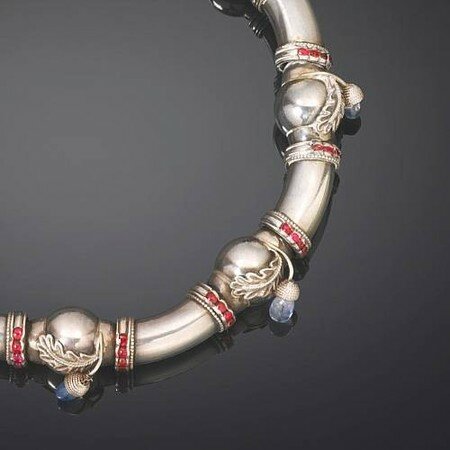A silver and gem-set choker, by Sah Oved, circa 1935
A silver and gem-set choker, by Sah Oved, circa 1935
The hollow tubular links, each with foiled ruby terminals, alternating with spherical spacers, with applied silver leaves and moonstone acorns, unsigned, interior circumference 39.0cm. Sold for £2,600 plus Premium and tax
Note : The British designer Sah Oved (1900-1983) was responsible for some of the most original and striking jewellery designs before the Second World War. Born Gwendolyn Ethel Rendle, the daughter of a country doctor, she had a very English upbringing. She trained under John Paul Cooper until 1923 and her student pieces from this period reflect the medievalism at the heart of arts and crafts design - not just in subject matter, but also in technical expertise. From 1924, she had her own studio and traded as “Miss Rendle of Doughty Street”.
Perhaps the most significant moment of her professional and personal life came around 1927 when she met Mosheh Oved, the charismatic owner of the celebrated antique shop, Cameo Corner, which boasted a treasure in precious materials, objets d’art and cameos and a varied international clientele of collectors, intellectuals, artists and royalty. Mosheh presided over his kingdom wearing a long purple velvet robe and a large amethyst on gold rope hung from his neck. Queen Mary was a regular visitor and her Daimler was often seen parked outside, with a red carpet stretching from the shop door to the pavement. The Oveds counted Jacob Epstein as one of their friends and his sculpture of Sah is in the Israel Museum, Jerusalem.
Working for Cameo Corner, Sah undertook repair work, engraving, enameling and commissions. The shop provided her with a wealth of raw materials to incorporate into her inventive designs and Mosheh’s Polish/Jewish background provided the cultural motivation. Despite her parents’ disapproval, she changed her name and remained with Mosheh until his death.
The majority of Sah’s jewellery designs was executed prior to 1938 and were distinctive and exclusive private commissions, which took several years in the making. The poet Edith Sitwell, the novelist Marghanita Laski and Nancy Cunard were among her clients. Sah was a peerless artisan and her trademark jewels from this period are all worked in high carat gold, in an impressive range of techniques. They are set with a smattering of gemstones and incorporate engraved inscriptions as unifying elements. Sah was constantly devising new ways of linking. When antique jewels in old Cameo Corner cases come up for sale at auction, if there is an ingenious clasp mechanism, it is usually one of Sah’s inspired repairs or alterations.
After the Second World War, Sah took up silversmithing at The Central School of Arts and Crafts, she published The Book of Necklaces in 1953 and contributed several pieces to The International Exhibition of Modern Jewellery at Goldsmith’s Hall in 1961. One of her last jewellery commissions was for the necklace on the tomb of Queen Elizabeth I at Westminster Abbey.
Bibliography: Hinks, Peter, Twentieth Century British Jewellery, 1900-1980, London 1983
Cartlidge, Barbara, Twentieth-Century Jewelry, Switzerland, 1985
Bonhams. Fine Jewellery, 6 Dec 2007. New Bond Street

/https%3A%2F%2Fprofilepics.canalblog.com%2Fprofilepics%2F1%2F0%2F100183.jpg)
/https%3A%2F%2Fstorage.canalblog.com%2F03%2F02%2F119589%2F96711876_o.jpg)
/https%3A%2F%2Fstorage.canalblog.com%2F11%2F31%2F119589%2F94773502_o.jpg)
/https%3A%2F%2Fstorage.canalblog.com%2F20%2F83%2F119589%2F94772815_o.jpg)
/https%3A%2F%2Fstorage.canalblog.com%2F26%2F72%2F119589%2F75604929_o.jpg)
/https%3A%2F%2Fstorage.canalblog.com%2F59%2F60%2F119589%2F26458628_o.jpg)



/image%2F1371349%2F20240418%2Fob_ac5c4c_telechargement.jpg)
/image%2F1371349%2F20240418%2Fob_709b64_304-1.jpg)
/image%2F1371349%2F20240418%2Fob_22f67e_303-1.jpg)
/image%2F1371349%2F20240417%2Fob_9708e8_telechargement.jpg)